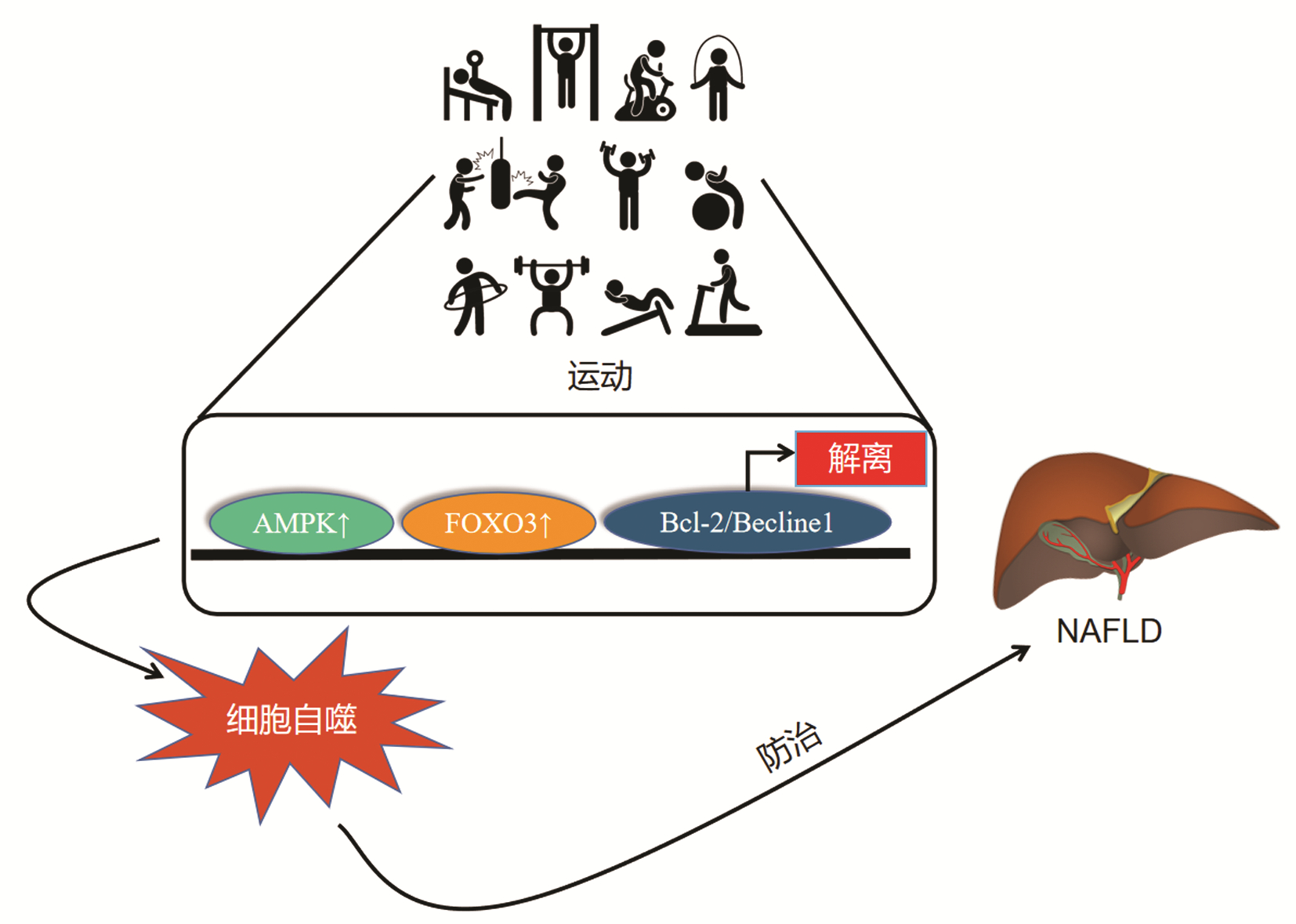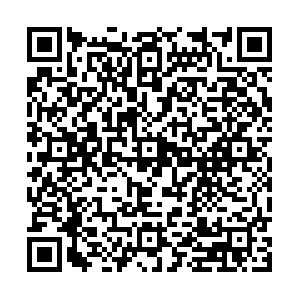运动诱导细胞自噬在非酒精性脂肪性肝病防治中的作用
DOI: 10.3969/j.issn.1001-5256.2022.05.038
利益冲突声明:所有作者均声明不存在利益冲突。
作者贡献声明:廖粤生负责课题设计,收集与分析资料,撰写和修改论文; 白莉莉负责拟定写作思路,指导撰写文章并最后定稿。
Role of exercise-induced autophagy in prevention and treatment of nonalcoholic fatty liver disease
-
摘要: 非酒精性脂肪性肝病(NAFLD)是一种以慢性肝损伤为主要特征的代谢性疾病。流行病学调查显示,NAFLD的发病率呈现不断上升的趋势,已严重威胁人类的生命健康。研究表明,自噬失调是NAFLD的重要病理生理机制,运动作为一种重要的非药物治疗手段,可通过诱导细胞自噬起到防治NAFLD的作用,但其确切机制尚不清楚。本文梳理与总结自噬与NAFLD的关系、运动诱导细胞自噬对NAFLD的影响以及其潜在分子机制的相关理论研究和应用成果,以期为NAFLD的预防与治疗提供理论参考。Abstract: Nonalcoholic fatty liver disease (NAFLD) is a metabolic disease characterized by chronic liver damage. Epidemiological surveys have shown that the incidence rate of NAFLD is increasing constantly and NAFLD has become a serious threat to human life and health. Studies have shown that autophagy dysregulation is an important pathophysiological mechanism of NAFLD, and exercise, as an important non-pharmacological treatment, can prevent and treat NAFLD by inducing autophagy, but its exact mechanism is still unclear. This article summarizes the theoretical studies and application results related to the association between autophagy and NAFLD, the effect of exercise-induced autophagy on NAFLD, and its potential molecular mechanism, in order to provide a theoretical reference for the prevention and treatment of NAFLD.
-
Key words:
- Non-alcoholic Fatty Liver Disease /
- Autophagy /
- Exercise
-
表 1 不同运动类型/周期诱导细胞自噬对NAFLD的影响
Table 1. Effects of outophagy induced by different exercise types/cycles on NAFLD
研究对象 运动类型/周期 研究结果 文献 小鼠 有氧运动 Atg6↑, p62↓细胞自噬水平↑ [23] 小鼠 有氧运动 细胞自噬水平↑ [24] 小鼠 抗阻运动 AKT Thr308↑,mTOR Ser2448↑,ULK1 Ser757↑, 细胞自噬水平↓ [26] 大鼠 抗阻运动 细胞自噬水平↓ [27] 大鼠 抗阻运动 LC3Ⅱ↑,Beclin1↑,Atg7↑细胞自噬水平↑ [28] 小鼠 一次跑台训练(50 min,12.3 m/min) LC3Ⅱ↓,Beclin1↓,Atg↓,AMP2↓细胞自噬水平↓ [29] 小鼠 一次跑台训练(90 min,55% VO2max) LC3Ⅱ↑,LC3Ⅱ/LC3Ⅰ↑细胞自噬水平↑ [30] 运动员 一次有氧运动(55%VO2max; 70%VO2max) LC3Ⅱ/LC3Ⅰ↓,p62不变; LC3Ⅱ/ LC3Ⅰ↑,p62↓ [31] 小鼠 4周有氧运动 LC3Ⅱ↑,LC3Ⅱ/LC3Ⅰ↑,Beclin1↑,Bnip3↑,Atg7↑,p62↓细胞自噬水平↑ [32] 大鼠 8周有氧运动(5次/周,60 min/次,25 m/min) Beclin1↑,LC3Ⅱ↑细胞自噬水平↑ [33] 注:↑表示上升; ↓表示下降。 -
[1] KOUZU K, TSUJIMOTO H, NISHIKAWA M, et al. Risk factors for nonalcoholic fatty liver disease after gastrectomy for gastric cancer[J]. Gastric Cancer, 2020, 23(2): 356-362. DOI: 10.1007/s10120-019-01009-8. [2] LI J, ZOU B, YEO YH, et al. Prevalence, incidence, and outcome of non-alcoholic fatty liver disease in Asia, 1999-2019: A systematic review and meta-analysis[J]. Lancet Gastroenterol Hepatol, 2019, 4(5): 389-398. DOI: 10.1016/S2468-1253(19)30039-1. [3] ESTES C, ANSTEE QM, ARIAS-LOSTE MT, et al. Modeling NAFLD disease burden in China, France, Germany, Italy, Japan, Spain, United Kingdom, and United States for the period 2016-2030[J]. J Hepatol, 2018, 69(4): 896-904. DOI: 10.1016/j.jhep.2018.05.036. [4] VION AC, KHELOUFI M, HAMMOUTENE A, et al. Autophagy is required for endothelial cell alignment and atheroprotection under physiological blood flow[J]. Proc Natl Acad Sci U S A, 2017, 114(41): e8675-e8684. DOI: 10.1073/pnas.1702223114. [5] XIAO WS, LE YY, ZENG SL, et al. Research advances in the pathogenesis of nonalcoholic fatty liver disease[J]. J Clin Hepatol, 2020, 36(8): 1874-1879. DOI: 10.3969/j.issn.1001-5256.2020.08.043.肖伟松, 乐滢玉, 曾胜澜, 等. 非酒精性脂肪性肝病的发病机制研究进展[J]. 临床肝胆病杂志, 2020, 36(8): 1874-1879. DOI: 10.3969/j.issn.1001-5256.2020.08.043. [6] GRUMATI P, COLETTO L, SCHIAVINATO A, et al. Physical exercise stimulates autophagy in normal skeletal muscles but is detrimental for collagen VI-deficient muscles[J]. Autophagy, 2011, 7(12): 1415-1423. DOI: 10.4161/auto.7.12.17877. [7] KLIONSKY DJ. Autophagy: From phenomenology to molecular understanding in less than a decade[J]. Nat Rev Mol Cell Biol, 2007, 8(11): 931-937. DOI: 10.1038/nrm2245. [8] KIM KH, LEE MS. Autophagy-a key player in cellular and body metabolism[J]. Nat Rev Endocrinol, 2014, 10(6): 322-337. DOI: 10.1038/nrendo.2014.35. [9] HE C, KLIONSKY DJ. Regulation mechanisms and signaling pathways of autophagy[J]. Annu Rev Genet, 2009, 43: 67-93. DOI: 10.1146/annurev-genet-102808-114910. [10] VELLAI T. Autophagy genes and ageing[J]. Cell Death Differ, 2009, 16(1): 94-102. DOI: 10.1038/cdd.2008.126. [11] KLIONSKY DJ. The molecular machinery of autophagy: Unanswered questions[J]. J Cell Sci, 2005, 118(Pt 1): 7-18. DOI: 10.1242/jcs.01620. [12] ZHAO JH, MA XY, XU JY, et al. Research advances in related factors for autophagy in the regulation of nonalcoholic fatty liver disease[J]. J Clin Hepatol, 2021, 37(7): 1713-1717. DOI: 10.3969/j.issn.1001-5256.2021.07.050.赵佳鹤, 马欣雨, 徐敬娅, 等. 自噬与非酒精性脂肪性肝病调控相关因子的关系[J]. 临床肝胆病杂志, 2021, 37(7): 1713-1717. DOI: 10.3969/j.issn.1001-5256.2021.07.050. [13] WANG Y, CHE Y, GAO YX, et al. Effect of expression of autophagy related gene Atg7 on replication of hepatitis B virus[J]. China Med Herald, 2020, 17(2): 4-8. https://www.cnki.com.cn/Article/CJFDTOTAL-YYCY202002002.htm王阳, 车阳, 高玉雪, 等. 自噬相关基因Atg7的表达对乙型肝炎病毒复制的影响[J]. 中国医药导报, 2020, 17(2): 4-8. https://www.cnki.com.cn/Article/CJFDTOTAL-YYCY202002002.htm [14] QUAN M, DUAN Y, XING HC. Research progress on alcoholic fatty liver disease and autophagy[J/CD]. Chin J Liver Dis (Electronic Version), 2021, 13(3): 25-29. DOI: 10.3969/j.issn.1674-7380.2021.03.004.全敏, 段英, 邢卉春. 酒精性脂肪性肝病与细胞自噬研究进展[J/CD]. 中国肝脏病杂志(电子版), 2021, 13(3): 25-29. DOI: 10.3969/j.issn.1674-7380.2021.03.004. [15] NEUSCHWANDER-TETRI BA. Hepatic lipotoxicity and the pathogenesis of nonalcoholic steatohepatitis: The central role of nontriglyceride fatty acid metabolites[J]. Hepatology, 2010, 52(2): 774-788. DOI: 10.1002/hep.23719. [16] AMIR M, CZAJA MJ. Autophagy in nonalcoholic steatohepatitis[J]. Expert Rev Gastroenterol Hepatol, 2011, 5(2): 159-166. DOI: 10.1586/egh.11.4. [17] SINGH R, KAUSHIK S, WANG Y, et al. Autophagy regulates lipid metabolism[J]. Nature, 2009, 458(7242): 1131-1135. DOI: 10.1038/nature07976. [18] ZHOU F, PENG JW, FAN FG, et al. Interrelation between autophagy and oxidative stress in pathogenesis of nonalcoholic fatty liver[J]. J Clin Hepatol, 2018, 34(8): 1805-1808. DOI: 10.3969/j.issn.1001-5256.2018.08.048.周帆, 彭君伟, 范伏岗, 等. 自噬与氧化应激在非酒精性脂肪性肝病发病机制中的关系[J]. 临床肝胆病杂志, 2018, 34(8): 1805-1808. DOI: 10.3969/j.issn.1001-5256.2018.08.048. [19] SINGH R, CUERVO AM. Autophagy in the cellular energetic balance[J]. Cell Metab, 2011, 13(5): 495-504. DOI: 10.1016/j.cmet.2011.04.004. [20] BURMAN C, KTISTAKIS NT. Regulation of autophagy by phosphatidylinositol 3-phosphate[J]. FEBS Lett, 2010, 584(7): 1302-1312. DOI: 10.1016/j.febslet.2010.01.011. [21] MEIJER AJ, CODOGNO P. Signalling and autophagy regulation in health, aging and disease[J]. Mol Aspects Med, 2006, 27(5-6): 411-425. DOI: 10.1016/j.mam.2006.08.002. [22] DELARUE J, MAGNAN C. Free fatty acids and insulin resistance[J]. Curr Opin Clin Nutr Metab Care, 2007, 10(2): 142-148. DOI: 10.1097/MCO.0b013e328042ba90. [23] LIRA VA, OKUTSU M, ZHANG M, et al. Autophagy is required for exercise training-induced skeletal muscle adaptation and improvement of physical performance[J]. FASEB J, 2013, 27(10): 4184-4193. DOI: 10.1096/fj.13-228486. [24] LIU X, YUAN H, NIU Y, et al. The role of AMPK/mTOR/S6K1 signaling axis in mediating the physiological process of exercise-induced insulin sensitization in skeletal muscle of C57BL/6 mice[J]. Biochim Biophys Acta, 2012, 1822(11): 1716-1726. DOI: 10.1016/j.bbadis.2012.07.008. [25] FERRARO E, GIAMMARIOLI AM, CHIANDOTTO S, et al. Exercise-induced skeletal muscle remodeling and metabolic adaptation: Redox signaling and role of autophagy[J]. Antioxid Redox Signal, 2014, 21(1): 154-176. DOI: 10.1089/ars.2013.5773. [26] STEINER JL, GORDON BS, LANG CH. Moderate alcohol consumption does not impair overload-induced muscle hypertrophy and protein synthesis[J]. Physiol Rep, 2015, 3(3): e12333-e12343. DOI: 10.14814/phy2.12333. [27] FENG Y. Effects of anti-resistance exercise on autophagy and inflammatory factors in adipose tissue of obese rats induced by high fat diet[J]. Genom Applied Biol, 2020, 39(2): 867-873. DOI: 10.13417/j.gab.039.000867.冯燕. 抗阻运动对高脂饮食诱导的肥胖大鼠脂肪组织自噬和炎症因子的影响[J]. 基因组学与应用生物学, 2020, 39(2): 867-873. DOI: 10.13417/j.gab.039.000867. [28] KWON I, JANG Y, CHO JY, et al. Long-term resistance exercise-induced muscular hypertrophy is associated with autophagy modulation in rats[J]. J Physiol Sci, 2018, 68(3): 269-280. DOI: 10.1007/s12576-017-0531-2. [29] KIM YA, KIM YS, SONG W. Autophagic response to a single bout of moderate exercise in murine skeletal muscle[J]. J Physiol Biochem, 2012, 68(2): 229-235. DOI: 10.1007/s13105-011-0135-x. [30] LEVINE B, KROEMER G. Autophagy in the pathogenesis of disease[J]. Cell, 2008, 132(1): 27-42. DOI: 10.1016/j.cell.2007.12.018. [31] SCHWALM C, JAMART C, BENOIT N, et al. Activation of autophagy in human skeletal muscle is dependent on exercise intensity and AMPK activation[J]. FASEB J, 2015, 29(8): 3515-3526. DOI: 10.1096/fj.14-267187. [32] LIRA VA, OKUTSU M, ZHANG M, et al. Autophagy is required for exercise training-induced skeletal muscle adaptation and improvement of physical performance[J]. FASEB J, 2013, 27(10): 4184-4193. DOI: 10.1096/fj.13-228486. [33] ROCHA-RODRIGUES S, GONÇALVES IO, BELEZA J, et al. Effects of endurance training on autophagy and apoptotic signaling in visceral adipose tissue of prolonged high fat diet-fed rats[J]. Eur J Nutr, 2018, 57(6): 2237-2247. DOI: 10.1007/s00394-017-1500-5. [34] BAYOD S, DEL VALLE J, PELEGRI C, et al. Macroautophagic process was differentially modulated by long-term moderate exercise in rat brain and peripheral tissues[J]. J Physiol Pharmacol, 2014, 65(2): 229-239. [35] National Workshop on Fatty Liver and Alcoholic Liver Disease, Chinese Society of Hepatology, Chinese Medical Association, Fatty Liver Expert Committee, Chinese Medical Doctor Association. Guidelines of prevention and treatment for nonalcoholic fatty liver disease: A 2018 update[J]. J Clin Hepatol, 2018, 34(5): 947-957. DOI: 10.3969/j.issn.1001-5256.2018.05.007.中华医学会肝病学分会脂肪肝和酒精性肝病学组, 中国医师协会脂肪性肝病专家委员会. 非酒精性脂肪性肝病防治指南(2018年更新版)[J]. 临床肝胆病杂志, 2018, 34(5): 947-957. DOI: 10.3969/j.issn.1001-5256.2018.05.007. [36] HARDIE DG. Minireview: The AMP-activated protein kinase cascade: The key sensor of cellular energy status[J]. Endocrinology, 2003, 144(12): 5179-5183. DOI: 10.1210/en.2003-0982. [37] KIM J, KUNDU M, VIOLLET B, et al. AMPK and mTOR regulate autophagy through direct phosphorylation of Ulk1[J]. Nat Cell Biol, 2011, 13(2): 132-141. DOI: 10.1038/ncb2152. [38] PAGANO AF, PY G, BERNARDI H, et al. Autophagy and protein turnover signaling in slow-twitch muscle during exercise[J]. Med Sci Sports Exerc, 2014, 46(7): 1314-1325. DOI: 10.1249/MSS.0000000000000237. [39] TONG W, JU L, QIU M, et al. Liraglutide ameliorates non-alcoholic fatty liver disease by enhancing mitochondrial architecture and promoting autophagy through the SIRT1/SIRT3-FOXO3a pathway[J]. Hepatol Res, 2016, 46(9): 933-943. DOI: 10.1111/hepr.12634. [40] VAINSHTEIN A, TRYON LD, PAULY M, et al. Role of PGC-1α during acute exercise-induced autophagy and mitophagy in skeletal muscle[J]. Am J Physiol Cell Physiol, 2015, 308(9): C710-C719. DOI: 10.1152/ajpcell.00380.2014. [41] HE C, BASSIK MC, MORESI V, et al. Exercise-induced BCL2-regulated autophagy is required for muscle glucose homeostasis[J]. Nature, 2012, 481(7382): 511-515. DOI: 10.1038/nature10758. -



 PDF下载 ( 2114 KB)
PDF下载 ( 2114 KB)


 下载:
下载:


